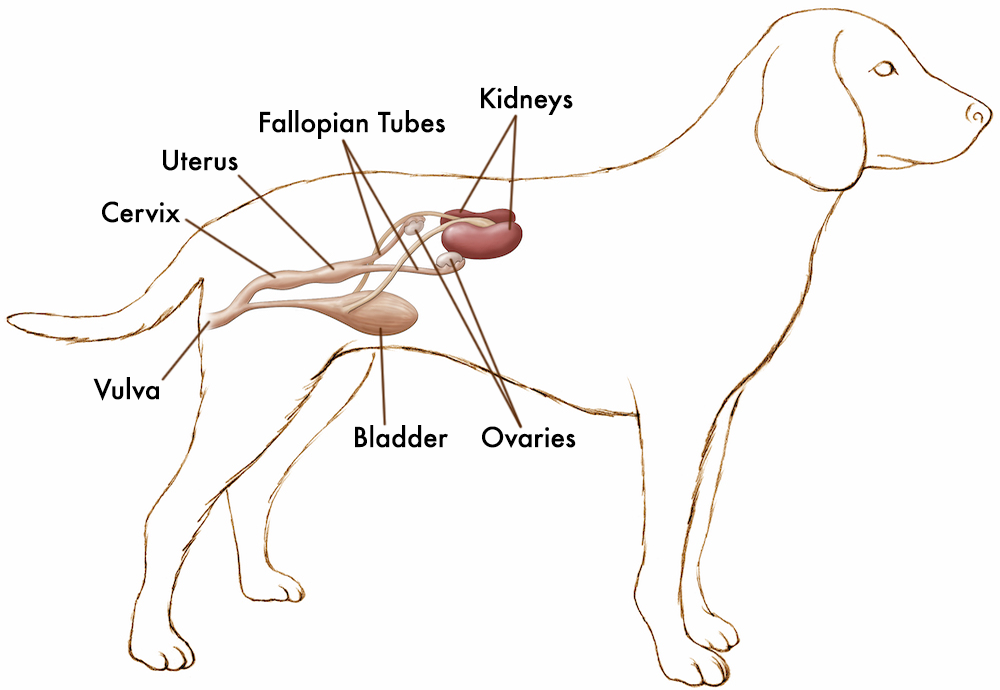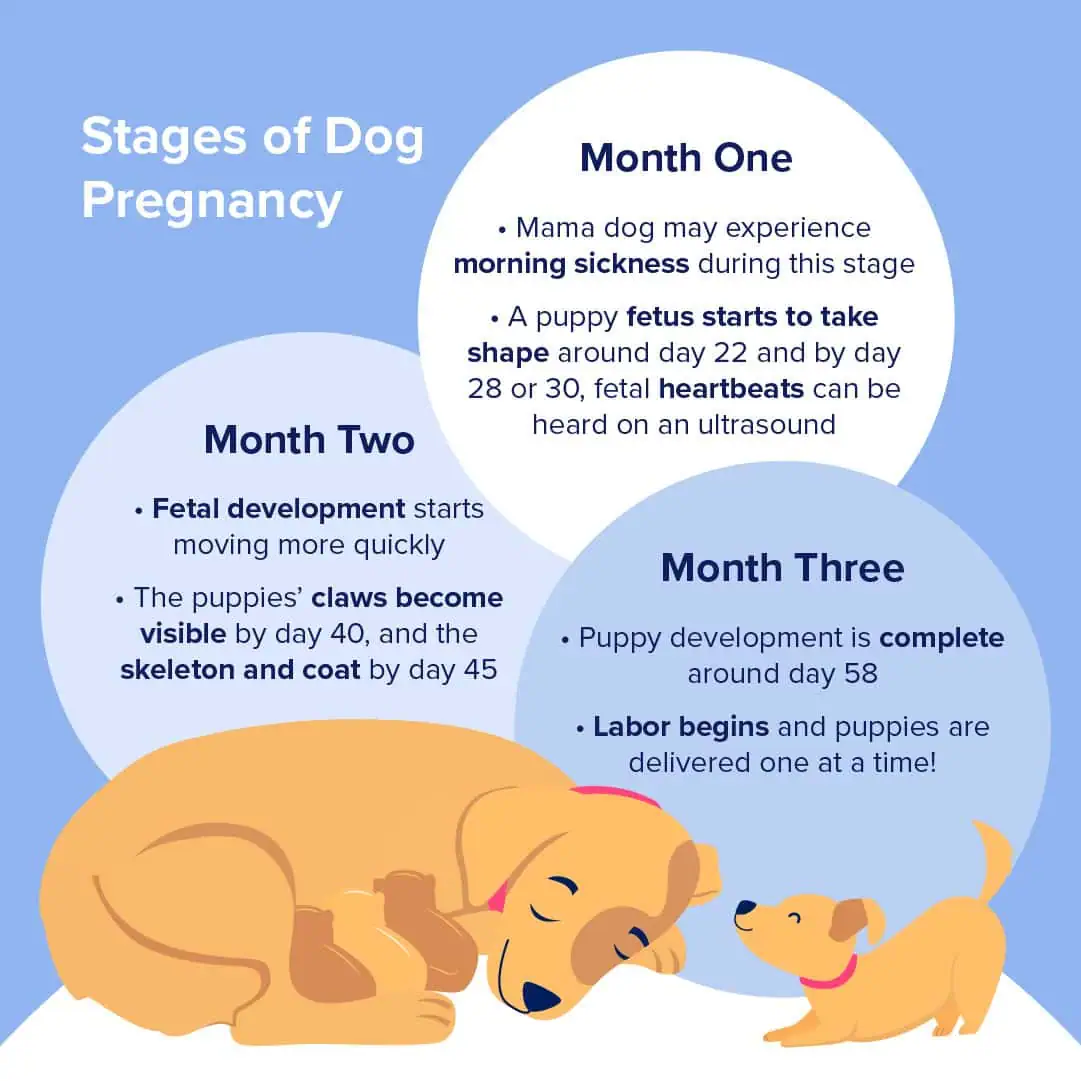Discover the differences between true and false pregnancy or pseudo-pregnancy in dogs, as well as the causes, symptoms, diagnosis and treatment options. This in-depth guide provides pet owners with essential knowledge about canine reproductive health.
Table of Contents
Introduction to Canine Reproductive Health

Dogs’ reproductive health is important to pet owners, but it’s frequently not understood. Real and fake pregnancies (which look the same but mean different things) are confusing. Real pregnancy results in puppies; fake pregnancy does all the same things, but has no puppies. This blog helps clear up these conditions, detailing the causes and signs of the problem, how to know for sure and what to do about it.
Understanding True Pregnancy in Dogs
True pregnancy happens when a female dog mates successfully during her fertile period, leading to fertilisation and growing embryos. This natural process ends with puppies being born after the Gestation Period. True pregnancy is an incredible adventure that has to be monitored very closely to make certain the mommy and her babies are healthy.
Key Characteristics of True Pregnancy
- Gestation Period: Dogs are usually pregnant for 60–70 days.
- Physical Signs: A pregnant dog’s tummy will be larger than a normal dog’s due to the developing puppies. Weight gain is typical, and mammary glands mature, sometimes producing milk around the delivery period.
- Behavioural Changes: Pregnant dogs might look for quiet, comfortable places to prepare for birth. They become more loving and protective.
- Veterinary Confirmation: True pregnancy can be confirmed with tools like ultrasound, which finds baby heartbeats, or X-rays, showing baby skeletons later on. Blood tests checking relaxin hormone levels are also used.
Stages of True Pregnancy

Actual pregnancy in dogs has these stages:
- Early Stage (Days 1–30): Fertilisation happens, and the embryo attaches to the uterus. Physical changes are minor, but hormone shifts begin.
- Mid-Stage (Days 31–50): The belly gets bigger, and baby growth speeds up. Vets can confirm pregnancy with an ultrasound now.
- Late Stage (Days 51–70): Puppies are fully grown, and the dog prepares for birth. Mammary glands start making milk, and nesting behaviours get stronger.
Caring for a pregnant dog involves a balanced diet, regular vet checkups, and a calm environment to keep the female dog healthy.
Exploring False Pregnancy in Dogs
False pregnancy, also called pseudopregnancy or phantom pregnancy, happens when a non-pregnant female dog shows symptoms like a real pregnancy. Hormone changes cause this, and it’s pretty standard in unspayed females, especially after a heat cycle.

Key Characteristics of False Pregnancy
- Hormonal Basis: False pregnancy starts with high levels of progesterone and prolactin after a heat cycle, even if no mating happens.
- Physical Signs: Dogs might have a swollen belly, bigger mammary glands, and milk. These signs look like actual pregnancy, but there are no growing babies.
- Behavioural Changes: Dogs may begin to nest, adopt toys or blankets as fake puppies, show restlessness, irritability, and lethargy.
- Duration: Symptoms usually go away in 2–3 weeks, but sometimes they last longer and need a vet’s help.
Why False Pregnancy Happens
False pregnancy has existed since dogs were not domesticated. In wild dog groups, non-pregnant females often showed false pregnancy signs to help take care of the leading female’s puppies. This hormonal response lets them make milk and help out, and that’s good for the group. This characteristic lingers in domestic dogs today, especially in unspayed females, whose bodies continue to have cycles.
True vs. False Pregnancy: A Detailed Comparison
The following table provides a side-by-side comparison between true and false pregnancy:
| Aspect | True Pregnancy | False Pregnancy |
|---|---|---|
| Cause | Successful Mating | Hormonal Changes post-estrus |
| Puppy Development | Puppies develop and are born | No puppies develop |
| Physical Symptoms | Abdominal enlargement, milk production | Abdominal enlargement, milk production |
| Behavioral Changes | Nesting, affection, and protectiveness | Nesting, toy adoption, irritability |
| Duration | 60–70 days | 2–3 weeks (may vary) |
| Diagnosis | Ultrasound, X-ray, and a relaxin blood test | Veterinary exam, symptom observation |
This comparison highlights the fundamental difference: true pregnancy involves actual fetal development, while false pregnancy is a hormonal mimicry without gestation.
Causes and Risk Factors
Knowing the causes and risks of both conditions helps pet owners get ready and manage them well.
Causes of True Pregnancy
- Mating During Estrus: True pregnancy happens when a female dog mates during fertile days, usually 9–13 days into her heat cycle.
- Fertility Factors: Healthy, younger dogs tend to get pregnant more, but all breeds and ages can get pregnant if mating happens.
Causes of False Pregnancy
- Hormonal Imbalance: After the heat cycle, progesterone levels go up and then down, starting prolactin production, which causes pregnancy-like symptoms.
- Evolutionary Trait: As said, false pregnancy is an old trait that’s still in pet dogs.
- Lack of Spaying: Unspayed females are more at risk, as spaying stops the hormone cycles, causing false pregnancy.
Risk Factors
- Breed Predisposition: Breeds like Beagles, Dachshunds, and Pointers might get false pregnancies, but it can happen in any breed.
- Reproductive History: Dogs that were never pregnant or have weird heat cycles might be more likely to get a false pregnancy.
- Age: While it can happen at any age, it’s more common in middle-aged, unspayed females.
Recognising Symptoms: True vs. False Pregnancy
Both real and fake pregnancies show similar symptoms, making it hard for pet owners to tell them apart without a vet’s help. Here’s a detailed list of symptoms for each condition.

Symptoms of True Pregnancy
- Abdominal Growth: The belly gets bigger because of the growing babies, noticeable by mid-pregnancy.
- Weight Gain: Pregnant dogs gain weight as the puppies grow and need more food.
- Mammary Gland Development: The mammary glands get bigger and might make milk, especially in the last weeks before birth.
- Appetite Changes: Pregnant dogs often eat more to help the babies grow.
- Nesting Behaviour: As birth gets closer, dogs might look for quiet spots, fix their bedding, or act protective.
- Physical Discomfort: Some dogs might seem uncomfortable or tired as the pregnancy progresses.
Symptoms of False Pregnancy
- Mild Abdominal Swelling: Hormones might make the belly look bigger, but no babies are causing this.
- Mammary Gland Changes: Glands get bigger and might make milk, which looks like an actual pregnancy.
- Behavioural Shifts: Dogs might “mother” toys, seem restless, or act extra clingy or mean.
- Appetite Fluctuations: Temporary changes in how much they eat, either more or less, might happen.
- Lethargy or Anxiety: Some dogs seem tired or worried because of hormone changes.
Recognising these symptoms is the first step, but you need a vet to know.
Diagnosing True and False Pregnancy
Vets use a mix of physical exams and tools to tell true from false pregnancy. Quick knowing ensures that the proper care happens and cuts down on worry.
Diagnostic Methods for True Pregnancy
- Ultrasound: Done around 25–35 days after mating, ultrasound finds baby heartbeats and confirms pregnancy.
- X-rays: Used later (after day 45), X-rays show baby skeletons, confirming the number of babies.
- Blood Tests: Tests for the relaxin hormone, only in pregnant dogs, give early confirmation.
- Physical Exam: Vets check belly changes, mammary growth, and other signs to help determine pregnancy.
Diagnostic Methods for False Pregnancy
- Symptom Evaluation: Vets look at the dog’s symptoms, reproductive history, and recent heat cycle to spot false pregnancy.
- Exclusion of Pregnancy: Ultrasound or blood tests make sure there are no babies, confirming a false pregnancy.
- Behavioural Assessment: Watching nesting or mothering actions helps confirm the guess.
Right knowing is key, as not handling a real pregnancy right or missing problems in a false one can hurt the dog’s health.
Managing True and False Pregnancy
The right way to handle it depends on whether the dog has a true or false pregnancy. Here are specific ways for each case.
Managing True Pregnancy
- Nutritional Support: Provide a top-quality, nutrient-rich diet made for pregnant dogs. Increase calorie intake slowly as the pregnancy progresses.
- Veterinary Care: Plan regular checkups to monitor the mom’s health and the baby’s growth. Ultrasounds and X-rays help determine how the puppies are doing.
- Exercise and Rest: Keep fit with mild exercise, but skip strenuous activities. Make a quiet, comfy spot for rest.
- Whelping Preparation: Set up a birthing box in a calm, private place. Fill it with clean bedding and ensure the mom can get in easily.
- Emergency Preparedness: Know the signs of labour and possible problems, like complicated births, and have your vet’s info ready.
Managing False Pregnancy
- Observation and Patience: Most cases improve independently in 2–3 weeks. Watch the symptoms and make the dog comfortable.
- Behavioural Interventions: Stop nesting or mothering actions by taking away toys or blankets the dog might “adopt.”
- Environmental Adjustments: Keep things calm, as stress can make symptoms worse.
- Medical Treatment: In severe or long-term cases, vets might administer hormone treatments to lower prolactin levels. Spaying is suggested for repeat cases.
- Comfort Measures: Offer reassurance and keep a routine to help the dog feel safe.
Spaying is a lasting way to stop false pregnancies and lower the risk of reproductive health problems, like pyometra or mammary tumours.
When to Consult a Veterinarian

Vet advice is key to keeping the dog healthy in true and false pregnancies. Get professional help if:
- Symptoms of false pregnancy don’t go away in 3–4 weeks or get worse.
- The dog shows distress signs, like too much tiredness, throwing up, or a weird discharge.
- You think there might be a real pregnancy and need confirmation or care before birth.
- Problems happen during a real pregnancy, like long labour or signs of infection.
Quick action can stop problems and calm pet owners.
Preventing False Pregnancy
The best way to stop false pregnancy is spaying, which takes out the ovaries and uterus, stopping hormone cycles. Spaying has more uses, like:
- Reduced Cancer Risk: Stops the chance of ovarian and uterine cancers and lowers mammary tumour chances.
- Prevention of Pyometra: Spaying stops this dangerous uterine infection.
- Behavioural Benefits: Cuts down on heat cycle actions, like wandering or meanness.
If you plan to breed, work closely with a vet to responsibly handle your dog’s reproductive health. Timed matings and regular checkups can reduce problems.
Long-Term Health Thoughts
Both true and false pregnancies show why it’s important to actively manage female dogs’ reproductive health. Unspayed dogs continue to face hormone imbalances, false pregnancies, and reproductive diseases. For breeding dogs, regular vet monitoring ensures that pregnancies go well and lowers risks to the mom and puppies.
Also, maintaining a healthy life through the right food, regular exercise, and mental fun supports overall well-being.
Common Myths and Misunderstandings
Several myths about true and false pregnancies in dogs confuse pet owners. Let’s clear up a few:
- Myth: False pregnancy is a sign of sickness. Fact: False pregnancy is a normal hormone response in unspayed dogs and usually gets better without problems.
- Myth: All dogs with swollen bellies are pregnant. Fact: Belly swelling can come from false pregnancy, weight gain, or health issues like bloat, needing a vet’s check.
- Myth: Spaying a dog during false pregnancy is risky. Fact: Spaying can be safely done once symptoms go away, stopping future episodes.
Knowing the truth helps pet owners make wise choices for their dogs’ care.
Supporting Your Dog Emotionally
Both true and false pregnancies can be complex for dogs emotionally. Pregnant dogs might feel unsure or worried as birth gets close, while dogs with false pregnancies might feel mixed up or upset because of hormone changes. Here’s how to give emotional support:
- Create a Safe Environment: Make a quiet, comfortable place where the dog can relax.
- Maintain Routine: Keeping the same feeding, exercise, and play schedule helps lower stress.
- Offer Reassurance: Kind petting, calm talking, and quality time strengthen your bond and comfort the dog.
- Monitor Behaviour: Look for signs of worry or meanness, and talk to a vet if behaviour changes stick around.
Emotional support boosts your dog’s toughness and builds a trusting bond.
FAQs
What Is Phantom Pregnancy in Dogs?
Phantom pregnancy, also known as false pregnancy, is a hormonal disorder that causes non-pregnant female dogs to show symptoms similar to a pregnant dog. The dog’s body goes through hormonal changes and thinks that it is pregnant. She will show symptoms of pregnancy, such as abdominal swelling, mammary gland enlargement, and nesting behaviours. It usually occurs a few weeks after a dog’s estrus cycle and is common in unspayed females.
What Causes False Pregnancy in Dogs?
False pregnancies occur due to hormonal imbalance after a dog’s heat cycle. After estrus, progesterone levels rise and then drop. This drop in progesterone triggers a release of prolactin, a hormone that encourages milk production and maternal behaviour. This hormonal change creates an environment similar to a real pregnancy, even if the dog wasn’t mated or fertilised. The trait is an evolutionary one, as it allowed non-pregnant females in wild canine packs to help care for the young.
How Long Does False Pregnancy Last in Dogs?
False pregnancy in dogs typically lasts 2 to 3 weeks. Symptoms typically begin four to eight weeks after a dog’s heat has ended and will naturally resolve once the hormone levels have stabilised. In some cases, symptoms may last up to 4–6 weeks if the dog is suffering from severe hormonal imbalances or stress. If the symptoms persist beyond this period, seek veterinary help.
Can Phantom Pregnancy in Dogs Be Dangerous?
In most cases, false pregnancy is not dangerous and resolves itself without complications. However, it can be unpleasant or distressing for the dog, especially if the symptoms are severe, such as excessive milk production and behavioural changes (aggression or anxiety). Occasionally, complications such as mastitis (an infection of the mammary glands) or prolonged hormonal imbalances may arise. Recurrent pseudopregnancies can also increase a dog’s susceptibility to other reproductive health issues, such as pyometra, and are a good reason to consider spaying.
What Are the Symptoms of False Pregnancy in Dogs?
Dogs that are going through a false pregnancy exhibit physical and behavioural changes that make it appear as if they are pregnant. Some of the Physical Symptoms are Mild abdominal swelling (not due to fetuses), enlarged mammary glands, sometimes with milk production, Appetite changes (increased or decreased), and Occasional vomiting or lethargy. Behavioural Symptoms include Nesting behaviours, such as rearranging bedding or seeking quiet spaces, “Mothering” objects like toys, blankets, or other items, Restlessness, irritability, or increased clinginess, Mild aggression or protectiveness in some cases. If you suspect your dog is experiencing these symptoms, a veterinary evaluation can help determine if the signs are due to false pregnancy or another medical condition.
Conclusion
Handling the ins and outs of true and false pregnancy in dogs needs knowledge, alertness, and kindness. Actual pregnancy is a fantastic process that brings new life, requiring careful care before birth and getting ready. False pregnancy, while usually harmless, can upset both dog and owner, requiring patience and sometimes vet help. Pet parents can ensure their dogs stay healthy and comfortable by understanding the causes, signs, and ways to handle both situations. Spaying gives a way to stop false pregnancies and long-term health pluses, while responsible breeding actions support successful true pregnancies. Always talk to a vet for personal advice, and put your dog’s well-being first with competent, active care.
References:
- False Pregnancy or Pseudopregnancy in Dogs | VCA Animal Hospitals
A comprehensive guide from VCA Animal Hospitals detailing the symptoms, hormonal causes, and treatment options for false pregnancy in dogs, including the recommendation for spaying to prevent recurrence. - Canine Pseudopregnancy: Prevalence and Treatment in the UK | PMC
A 2018 study from BMC Veterinary Research exploring the prevalence, diagnosis, and treatment protocols for pseudopregnancy in UK veterinary practices, with insights into breed predispositions and spaying considerations. - Phantom Pregnancy in Dogs – Symptoms & Treatment | Purina
A 2023 article from Purina outlining the signs, causes, and management of phantom pregnancy in dogs, including tips for distraction and when to seek veterinary care. - False Pregnancy in Dogs: Symptoms and Treatment | PetMD
A 2024 PetMD article by Dr. Aja Senestraro explaining the hormonal basis of false pregnancy, diagnostic methods, and treatment options, emphasizing the importance of ruling out true pregnancy. - Phantom Pregnancy in Dogs | PDSA
A guide from PDSA detailing the symptoms, potential complications (e.g., mastitis), and treatment options for phantom pregnancy, with advice on spaying to prevent future episodes.
